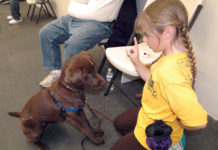What Did My Dog Swallow?
A couple nights ago, I awoke in the middle of the night to
that one sound that no dog owner can ignore: that lurching sound...
Does your dog have a rock solid recall?
Someone sent me a link to this news story about a Texas dog owner being caught on video (taken inadvertently by a neighbor’s Ring...
When Is the Right Time for Euthanasia?
I have a number of friends (and a family member) who have
dogs who are nearing the end of their days. I’m noting and processing...
Interesting Reads for Dog Lovers
It’s probably self-evident that most writers and editors
enjoy reading. We read professionally, and also for fun.
Lately, though, my reading has been getting in...
Plan ahead to socialize your puppy early!
Recently, I witnessed an older couple struggling to carry a
crate into a puppy kindergarten class. Once inside, they opened the crate and a
large and...
A Perfect New Home For My Foster Dog Odin
When, back in March, I scheduled a week-long vacation for
early July, I of course had no way of knowing a huge, dog-related story was
going...
Update on grain-free diets and DCM cases in dogs
On June 27, 2019, the United States Food and Drug Administration (FDA) released an update to two previous advisories regarding dog food and dogs...
Skunks and Fireworks Are NOT a Dog’s Best Friends
My senior dog Otto has never liked fireworks, but he’s never been a total wreck around the Independence Day holiday, either. He will pant...
Here’s Why We Can’t Just Keep Every Foster Dog
"Why don't you just keep him?"
Everyone who fosters dogs for a shelter or rescue group has heard some version of this, probably every single...
Keep Your Dog Safe from Accidents
In a 48-hour period last weekend, three dogs who are very
close to me ended up in veterinary emergency rooms. It was a very weird
aggregation...
When It Comes to Dog Training, Practice Makes Perfect
Anyone who has ever learned to do something physical –
hitting a baseball, sewing a garment, driving a car, you name it
– understands that you gain...
Memorable Things I’ve Learned From Pet Seminars
Continuing education is an awesome thing. I am so grateful that my publisher sends me to a couple of places or events each year...


















